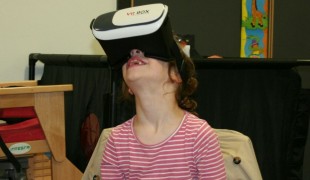- 7749
- 516
- 8
- 8
- 0
- Help Ukraine
About the solution
To help his son communicate, Richard devoted his energies to creating a kid-friendly form of speech technology he named Tango. The gadget prerecords a wide variety of colorful pictures and symbols depicting commonly used actions, questions and emotions.
His son, Thomas, can use the device to quickly select a thought and the little computer speaks for him, in a voice much like his own that expresses emotions with frases.
Thomas can go into a mode with one push of a button and change that from a regular voice to a whine or shout or a whisper. The computerized device can also be adapted for specific occasions, so before a baseball game, they downloaded the sound of cheers for their team so at the stadium their son could be one of the guys hollering for them.
Adapted from: https://abcn.ws/2M1ICaG
Watch the video: https://vimeo.com/42282589
这些解决方案不应包括使用药物,化学品或生物制品(包括食品);创伤性设备;冒犯性的,商业或内在危险的内容。该解决方案未经医学验证。请谨慎进行!如果您有任何疑问,请咨询健康专家。
DISCLAIMER: This story was written by someone who is not the author of the solution, therefore please be advised that, although it was written with the utmost respect for the innovation and the innovator, there can be some incorrect statements. If you find any errors please contact the patient Innovation team via info@patient-innovation.com
-
-
755
-
0
-
16919

Proloquo2Go – App to help people communicate
CAREGIVING
COMMUNICATION: Communicating, whether by speaking, listening, or other means
Social interaction
Paralysis
Autism
Cerebral Palsy
Brain Stroke
Brain Injury (Abscess, Brain Barrier Defect, Brain Contusion, Brain Hemorrhage, Brain Edema)
Assistive Daily Life Device (to help ADL)
Assistive Technology access
App (Including when connected with wearable)
Tremors
Muscle cramps or spasms
Difficulty coordinating movements
Muscle weakness
Difficulty speaking or understanding speech
Trouble with fine motor skills (e.g., writing, buttoning clothes)
Twitching or involuntary movements (myoclonus)
Acquired language impairment (Aphasia)
Promoting self-management
Managing Neurological Disorders
Building Supportive Community Relationships
Promoting inclusivity and social integration
Improving Speech and Communication
Caregiving Support
Clinical Pathology
Medical Genetics
Neurology
Pediatrics
Rheumatology
Netherlands
-
-
-
527
-
3
-
8147

Dad uses virtual reality to help his daughter who suffers from Williams Syndrome
COMMUNICATION: Communicating, whether by speaking, listening, or other means
Social interaction
foetal alcoholic syndrome
DiGeorge Syndrome
Angelman Syndrome
Neuromuscular Disorders
Assistive Technology access
App (Including when connected with wearable)
Difficulty coordinating movements
Difficulty speaking or understanding speech
Trouble with fine motor skills (e.g., writing, buttoning clothes)
Cognitive impairment
Memory loss
Anxiety
Sensitivity to light or sound
Depression or anxiety
Managing Neurological Disorders
Improving Speech and Communication
Caregiving Support
Medical Genetics
Neurology
Pediatrics
United Kingdom
-
-
-
955
-
0
-
20832

跟踪自闭症儿童的系统
CAREGIVING
COMMUNICATION: Communicating, whether by speaking, listening, or other means
Social interaction
Autism
Assistive Daily Life Device (to help ADL)
Body-Worn solutions (Clothing, accessories, shoes, sensors...)
App (Including when connected with wearable)
Anxiety
Difficulty concentrating or making decisions
Social withdrawal or isolation
Restlessness or feeling slowed down
Loss of interest or pleasure in activities (anhedonia)
Promoting self-management
Managing Neurological Disorders
Preventing (Vaccination, Protection, Falls, Research/Mapping)
Caregiving Support
Child and Adolescent Psychiatry
Medical Genetics
Neurology
Pediatrics
Psychiatry
Israel
-
 zh
zh